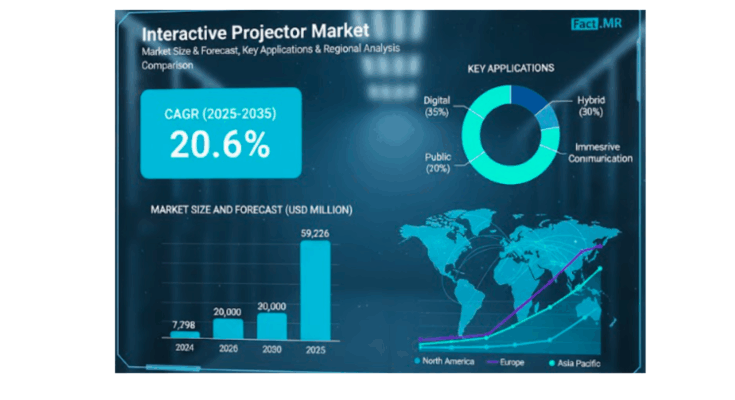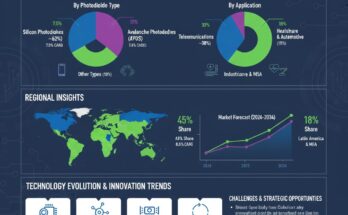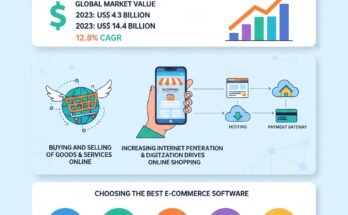The global interactive projector market is poised for unprecedented growth, projected to expand from USD 7,298 million in 2024 to USD 59,226 million by 2035, reflecting a robust CAGR of 20.6% during the forecast period (2025–2035). The rise of digital learning, hybrid work environments, and immersive communication tools has positioned interactive projectors as essential devices for enhancing engagement, collaboration, and knowledge retention across educational, corporate, and public sectors.
Interactive projectors go beyond conventional presentation technologies, enabling participatory learning, interactive meetings, and collaborative workflows. With increasing emphasis on smart classrooms, remote learning, and digital corporate infrastructure, these projectors are becoming indispensable in both mature and emerging economies.
Market Drivers: Education, Corporate Collaboration, and Digital Integration
The surge in digital classrooms and smart learning environments is a key catalyst for market growth. Interactive projectors foster collaboration, participatory learning, and better information retention, supporting improved academic performance and productivity. Government initiatives promoting digital education, such as “Smart Education China” and the Digital India program, further accelerate adoption across schools and universities.
In the corporate sphere, interactive projectors enhance dynamic presentations, remote meetings, and hybrid collaboration models. Their integration with cloud platforms, wireless connectivity, and smart devices enables seamless content sharing, real-time annotations, and interactive workshops, driving productivity and innovation.
Advancements in ultra-short-throw (UST) and laser-based projectors, combined with gesture recognition, multi-touch capabilities, and energy-efficient designs, are also shaping market expansion. Manufacturers increasingly focus on sustainability, portability, and user-friendly models to meet evolving consumer expectations.
Market Trends: Immersive Learning, Hybrid Work, and Smart Features
Ultra-short-throw projectors are gaining traction in space-constrained classrooms and offices, delivering large images from short distances while reducing shadows and glare. LCoS projection technology is emerging as a preferred option for advanced education and corporate applications, offering enhanced image fidelity, color accuracy, and smoother visuals.
The 3D projector segment is expanding steadily, driven by the demand for immersive, experiential learning and simulation-based training, particularly in healthcare, defense, and technical education. Touch-based interaction is surpassing pen-based systems due to intuitive usability, multi-touch functionality, and alignment with broader digital adoption trends.
Cloud integration, AI-powered image recognition, and hybrid system compatibility are becoming core differentiators, enabling seamless remote collaboration and real-time workflow management.
Regional Insights: North America, East Asia, and Western Europe Lead Adoption
North America dominates the interactive projector market due to early digital adoption, mature IT infrastructure, and robust government funding programs such as the U.S. E-Rate initiative. Educational institutions and corporate enterprises utilize interactive projectors to modernize workflows, enhance learning outcomes, and streamline remote collaboration.
East Asia, particularly China, South Korea, and Japan, is witnessing rapid market expansion. Investments in digital learning infrastructure, smart classrooms, and EdTech startups drive adoption, while government policies promote digitization in schools, healthcare, and enterprise workflows.
Western Europe maintains steady growth, supported by high digital literacy, well-established educational systems, and consistent integration of interactive technologies in both corporate and public sectors. Germany, the UK, and France lead adoption, reflecting favorable policies, significant investment in digital infrastructure, and innovation culture in professional training.
Country-Level Outlook
-
United States: Adoption is driven by secure digital workflow transformation in enterprise, healthcare, and government sectors, with AI-enabled classification and OCR integration improving data integrity and efficiency.
-
China: Growth is fueled by digitization policies, smart city initiatives, and enterprise-specific adoption of AI-powered image recognition and document management tools.
-
India: Momentum arises from government EdTech programs, hybrid classrooms, and enterprise digitization initiatives, supported by affordable local solutions and language-specific interfaces.
Competitive Landscape
The interactive projector market is highly competitive, shaped by technological innovation, product diversification, and strategic partnerships. Seiko Epson Corporation and BenQ Corporation dominate, accounting for over 35% of market share, offering advanced 3LCD and projection platforms. Dell Technologies, Optoma Technology, and Touchjet Inc. target enterprise and hybrid work solutions, ultra-short-throw systems, and portable touch-enabled models.
Emerging technologies such as AI-powered touch recognition, cloud collaboration, and mobile interactivity continue to influence purchasing decisions and user expectations. Manufacturers increasingly focus on lamp-free, ultra-short-throw projectors with enhanced image processing and integration with hybrid learning ecosystems.
Recent Developments
-
BenQ (November 2024): Launched LH835ST, LH850ST, and LU960UST+ simulation projectors for projection mapping, medical simulation, and immersive display applications, offering high performance and advanced features.
-
Epson (May 2024): Introduced a large venue 4K 3-chip 3LCD laser projector lineup at InfoComm 2024, enhancing hybrid workplace capabilities and classroom engagement with high-impact displays.
Segmentation Overview
-
By Projection Technology: DLP, LCD, LCoS
-
By Projection Type: Ultra Short Throw, Short Throw, Standard Throw
-
By Dimension: 2D, 3D
-
By Interaction Type: Pen-based, Touch-based
-
By Resolution: HD, Full HD, WXGA, 4K+
-
By Application: Interactive Learning, Collaboration, Digital Signage, Simulation & Training, Entertainment & Gaming
-
By End User: Education, Corporate, Government, Healthcare, Retail & Hospitality, Museums & Exhibitions
-
By Region: North America, Latin America, Western Europe, Eastern Europe, East Asia, South Asia & Pacific, Middle East & Africa
Conclusion
The interactive projector market is positioned for exponential growth, fueled by digital education initiatives, hybrid work models, immersive learning, and enterprise digitization. Manufacturers and industry leaders are presented with strategic opportunities to capitalize on market expansion by innovating in AI, cloud collaboration, ultra-short-throw technology, and energy-efficient, touch-based systems.
Browse Full Report : https://www.factmr.com/report/interactive-projector-market


